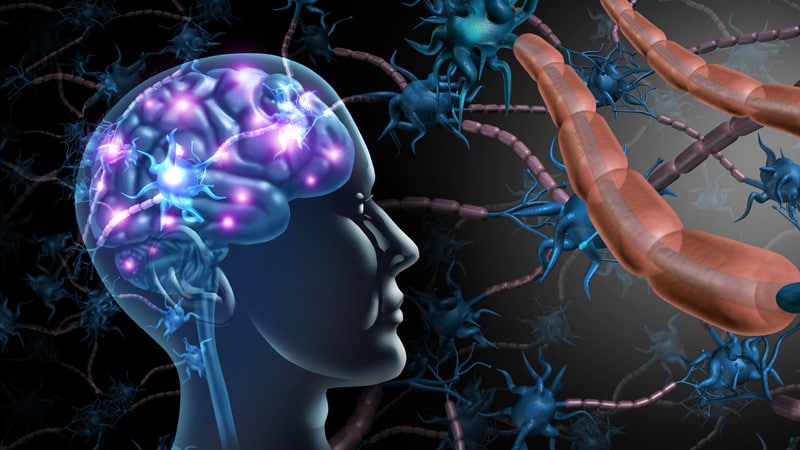The investigational anti-amyloid drug donanemab (Eli Lilly) significantly slowed cognitive and functional decline in a phase 3 study of adults with early symptomatic Alzheimer’s disease (AD), according to topline results hailed as highly encouraging by experts.
Donanemab met the primary endpoint, change from baseline until 18 months on the integrated Alzheimer’s Disease Rating Scale (iADRS), and all secondary endpoints measuring cognitive and functional decline, Eli Lilly said in a press release today announcing the topline data.
In the randomized, double-blind, placebo-controlled TRAILBLAZER-ALZ 2 trial, nearly half (47%) of patients taking donanemab had no clinical progression at 1 year, defined as no decline on the Clinical Dementia Rating-Sum of Boxes (CDR-SB), compared with 29% of patients on placebo (P < .001).
Donanemab also slowed clinical decline by 35% (P < .0001) compared with placebo and resulted in 40% less decline on the ability to perform activities of daily living (P < .0001).
Patients taking donanemab had a 39% lower risk of progressing to the next stage of disease compared to placebo (CDR-Global Score, hazard ratio [HR] 0.61; P < .001).
In addition to slowing cognitive and functional decline, donanemab led to significant reductions in brain amyloid plaque levels as early as 6 months after starting treatment.
As a result of achieving a prespecified level of amyloid plaque clearance, 52% of participants completed their course of treatment by 1 year and 72% completed treatment by 18 months, Eli Lilly said.
“These are the strongest phase 3 data for an Alzheimer’s treatment to date,” Maria C. Carrillo, PhD, Alzheimer’s Association chief science officer, said in a statement.
Participants in TRAILBLAZER-ALZ 2 were stratified by their level of the brain protein tau, a predictive biomarker for AD progression. The primary analysis population of 1182 patients, for which the study was powered, comprised people with an intermediate level of tau and clinical symptoms of AD.
The study also enrolled 552 people with high levels of tau at baseline, representing a later stage of disease progression.
In an analysis combining high tau and intermediate tau participants (n = 1736), donanemab also showed “meaningful positive” results across all clinical endpoints (P < .001), with CDR-SB and iADRS showing 29% and 22% slowing of decline, respectively, Eli Lilly said.
The incidence of amyloid-related imaging abnormalities (ARIA), a side effect of treatment, was consistent with the TRAILBLAZER-ALZ phase 2 study. The incidence of serious ARIA was 1.6%, including two participants whose death was attributed to ARIA and a third who died after an incident of serious ARIA.
In the overall donanemab treatment group, ARIA-E (cerebral edema) occurred in 24% of participants, with 6% experiencing symptomatic ARIA-E.
ARIA-H (cerebral microhemorrhages) occurred in 31.4% in the donanemab group and about 14% in the placebo group. Most cases of ARIA were mild to moderate and resolved or stabilized with appropriate management.
Infusion-related reactions occurred in 8.7% of participants with most cases mild to moderate in severity.
“Encouraging” Results, Full Data Highly Anticipated
In a statement from the British nonprofit Science Media Centre, Paresh Malhotra, PhD, professor of clinical neurology, Imperial College London, said these new findings “provide further evidence that antibody treatments that reduce amyloid in the brain can slow decline in thinking and the ability to carry out everyday activities in people with early Alzheimer’s disease.”
“These are really encouraging results and show that targeting fundamental mechanisms in Alzheimer’s can potentially make a difference to people’s lives,” said Malhotra.
Also weighing in, Catherine Mummery, MD, PhD, with University College London Hospitals NHS Foundation Trust in the UK, said the results confirm that “we are now entering the treatment era of Alzheimer’s disease.”
“After many years of negative trials, we now have consistent results across several anti-amyloid antibodies showing that removal of amyloid does change the course of the disease,” said Mummery.
Mummery also noted that the method of administration of the drug might reduce burden and cost of treatment.
“This drug was only given until amyloid was lowered to a low enough point, then stopped — which was 52% over 12 months and 72% over 18 months. This may provide a way of ‘inducing remission’ in Alzheimer’s and then monitoring without treatment,” Mummery said.
Liz Coulthard, MBBS, PhD, associate professor in dementia neurology, University of Bristol, UK, had a more cautious take on the topline data. “At face value, these data look positive, but we need to see the full dataset,” she said.
“There are significant side effects, and we need to know more about how these have affected people. We also need to know the longer-term effects of donanemab,” added Coulthard.
Additional data from the TRAILBLAZER-ALZ 2 trial will be presented at the Alzheimer’s Association International Conference (AAIC) in July.
The TRAILBLAZER-ALZ 2 trial was funded by Eli Lilly. Coulthard discloses receiving funding/payment from Biogen, Lilly, Novartis, UCB, and Eisai for consultancy and developing educational resources. Malhotra leads an NIHR-funded symptomatic trial of a repurposed medication in Alzheimer’s Disease and receives research funding from the Alzheimer’s Society, Dementias Platform UK, and NIHR.
For more Medscape Neurology news, join us on Facebook and Twitter
Source: Read Full Article






